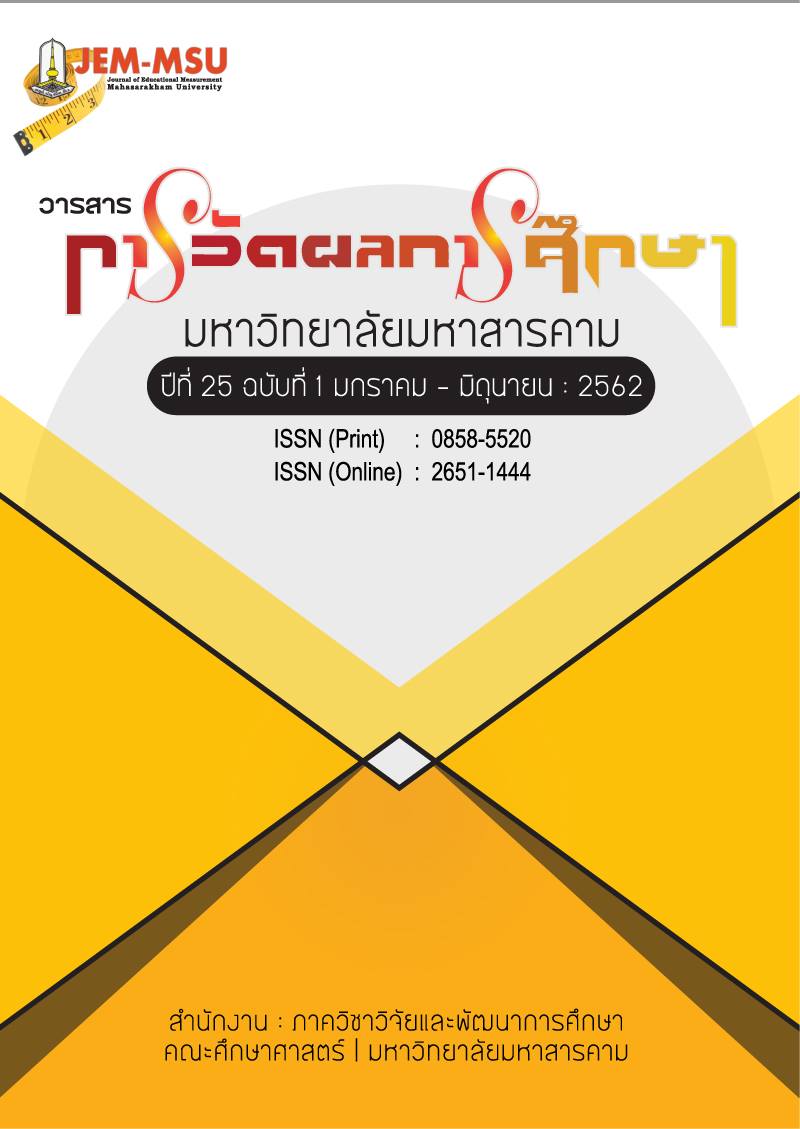Development of Organizing Science Learning, Using Graphic Organizers with GI Teaching to Promote Learning Achievement and Analytical Thinking Of Third Grade Students
Main Article Content
Abstract
The objectives of this study were: 1) to develop the lesson plans in science subject on the topic of Materials around Us, using graphic organizers with group investigation teaching for 3rd grade students to meet the criterion of 75/75; 2) to compare 3rd grade students' science learning achievement on Materials around Us and analytical thinking ability before and after learning through graphic organizers with group investigation teaching. The sample used in this study consisted of 25 students from Group 2 of the 3rd grade students at Chumchonbanphet (Wankroo 2500) School, under Chaiyaphum Primary Education Service Area Office 3 in the second semester of the academic year 2016, obtained through cluster random sampling. The research instruments consisted of 3 kinds as follows: 1) six lesson plans in science subject on the topic of Materials around Us, using graphic organizers with group investigation teaching. The allotted time was two hours for each plan; 2) a learning achievement test in science on the topic of Materials around Us, for 3rd grade students. The test contained 20 questions; 3) an analytical thinking ability tests for 3rd grade students, containing 15 questions. The statistics employed in data analysis were percentage, the mean ( ), standard deviation (S.D.), and Hotelling’s T2 (dependent samples) was employed in hypothesis testing. The findings are as follows:
1. The lesson plans in science subject on the topic of Materials around Us, using graphic organizers with group investigation teaching for 3rd grade students that had been constructed had the efficiency of 76.54/74.00, and it met the criterion of 75/75 with statistical significance at the .05 level.
2. The 3rd grade students' learning achievement in science subject on the topic of Materials around Us, and their analytical thinking ability, after learning through using graphic organizers with group investigation teaching, were higher than before learning, with statistical significance at the .05 level.
Article Details
The content and information contained in the published article in the Journal of Educational Measurement Mahasarakham University represent the opinions and responsibilities of the authors directly. The editorial board of the journal is not necessarily in agreement with or responsible for any of the content.
The articles, data, content, images, etc. that have been published in the Journal of Educational Measurement Mahasarakham University are copyrighted by the journal. If any individual or organization wishes to reproduce or perform any actions involving the entirety or any part of the content, they must obtain written permission from the Journal of Educational Measurement Mahasarakham University.
References
เขมณัฎฐ์ มิ่งศิริธรรม. (2554). “การบูรณาการวิธีการเรียนแบบร่วมมือกับการเรียนร่วมกัน” [ออนไลน์]. ได้จาก www.ejournal.su.ac.th/upload/261.pdf [สืบค้นเมื่อ วันที่ 25 มกราคม 2558].
จุฑารัตน์ ศรีสารคาม. (2553). การพัฒนาทักษะการคิดวิเคราะห์กลุ่มสาระการเรียนรู้วิทยาศาสตร์ ชั้นประถมศึกษาปีที่ 3 โรงเรียนบ้านบ่อน้อยหนองงัวสว่างวิทย์ โดยใช้เทคนิคผังกราฟิก. วิทยานิพนธ์คุรุศาสตรมหาบัณฑิต. มหาวิทยาลัยราชภัฏมหาสารคาม. มหาสารคาม.
ชัยยงค์ พรหมวงศ์. (2556). การทดสอบประสิทธิภาพสื่อหรือชุดการสอน. วารสารศิลปากรศึกษาศาสตร์วิจัย. ปีที่ 5 ฉบับที่ 1 (มกราคม - มิถุนายน 2556). หน้าแทรก 1.
ทรงศักดิ์ ภูสีอ่อน. (2551). การประยุกต์ใช้ SPSS วิเคราะห์ข้อมูลงานวิจัย. พิมพ์ครั้งที่ 2. กาฬสินธุ์ : ประสานการพิมพ์.
ทิศนา แขมมณี. (2552). ศาสตร์การสอน : องค์ความรู้เพื่อการจัดกระบวนการเรียนรู้ที่มีประสิทธิภาพ. พิมพ์ครั้งที่ 10. กรุงเทพฯ : สำนักพิมพ์แห่งจุฬาลงกรณ์มหาวิทยาลัย.
___________. (2553). ศาสตร์การสอน:องค์ความรู้เพื่อการจัดกระบวนการเรียนรู้ที่มีประสิทธิภาพ. พิมพ์ครั้งที่ 11. กรุงเทพฯ : สำนักพิมพ์แห่งจุฬาลงกรณ์มหาวิทยาลัย.
___________. (2555). ศาสตร์การสอน. กรุงเทพฯ : โรงพิมพ์แห่งจุฬาลงกรณ์มหาวิทยาลัย.
ทิศนา แขมมณี และคณะ. (2554). กลุ่มสัมพันธ์ เพื่อการทำงานและจัดการเรียนการสอน. กรุงเทพฯ : บิซินแอดเวอร์ไทซิ่ง.
บุญชม ศรีสะอาด และคณะ. (2553). พื้นฐานการวิจัยการศึกษา. พิมพ์ครั้งที่ 6. กาฬสินธุ์ : ประสานการพิมพ์.
ประพันธ์ศิริ สุเสารัจ. (2556). การพัฒนาการคิด. พิมพ์ครั้งที่ 5. กรุงเทพฯ : ห้างหุ้นส่วนจำกัด 9119 เทคนิคพริ้นดิ้ง.
พิมพันธ์ เดชะคุปต์ และ พเยาว์ ยินดีสุข. (2557). การจัดการเรียนในศตวรรษที่ 21. โรงพิมพ์แห่งจุฬาลงกรณ์มหาวิทยาลัย.
เมธินี ไชยพิมพ์. (2554). การพัฒนาผลสัมฤทธิ์ทางการเรียนรู้วิทยาศาสตร์เรื่อง สิ่งมีชีวิตกับสิ่งแวดล้อมของนักเรียน ชั้นประถมศึกษาปีที่ 6 โดยใช้เทคนิคกลุ่มสืบค้น. วิทยานิพนธ์คุรุศาสตรมหาบัณฑิต มหาวิทยาลัยราภัฏมหาสารคาม. มหาสารคาม.
ลักขณา อันทะปัญญา. (2556). การพัฒนาความสามารถในการคิดวิเคราะห์และผลสัมฤทธิ์ทางการเรียนวิชาวิทยาศาสตร์ของนักเรียนชั้นประถมศึกษาปีที่ 6 โดยใช้วัฏจักรการสืบเสาะหาความรู้ (Inquiry Cycle) ร่วมกับเทคนิคผังกราฟิก (Graphic Organizer Technique). วิทยานิพนธ์การศึกษามหาบัณฑิต. มหาวิทยาลัยขอนแก่น. ขอนแก่น.
วิจารณ์ พานิช. (2556). สนุกกับการเรียนในศตวรรษที่ 21. กรุงเทพฯ : มูลนิธีสดศรี-สฤษดิ์วงศ์.
สมนึก ภัททิยธนี. (2556). การวัดผลการศึกษา. พิมพ์ครั้งที่ 9. กาฬสินธุ์ : ประสานการพิมพ์.
อุมาภรณ์ ไชยเจริญ. (2556). ผลสัมฤทธิ์ทางการเรียนวิทยาศาสตร์ และความสามารถในการคิดวิเคราะห์โดยใช้การสอบรูปแบบซิปปา ร่วมกับเทคนิคการใช้คำถาม และเทคนิคการใช้ผังกราฟิกของนักเรียนชั้นประถมศึกษาปีที่ 6 วิทยานิพนธ์การศึกษามหาบัณฑิต. มหาวิทยาลัยทักษิณ.
Antonine Kristen Alana. (2013). The Effect of Graphic Organizers on Science Education : Human Body Systems. The Graduate Faculty of the student grade 11 in partial fulfillment of the requirements For Master of Natural Science.
Chairunnisa Connie. (2016). The Implementation of Group Investigation (GI) to Enhance Students’ Critical Thinking Skill in Educational program Evaluation Class. Graduate School. Indonesia.
Hawk Parmalee. (2016). Graphic Organizers: Increasing the Achievement of Life Science Students. Middle School Research Selected Studied, 11:1, 16-23, DOI : 10.1080/08851700.1986.11670269.
Joyce, B. and Weil, M. (1986). Model of Teaching (3rd Ed). United State of America: Pracice Hall Intermational.
Sangadji Sopiah. (2016). Implementation of Cooperative Learning with Group Investigation to improve learning Achievement of Vocational School. Students in Indonesia. Faculty of Economics, University of Malang.


